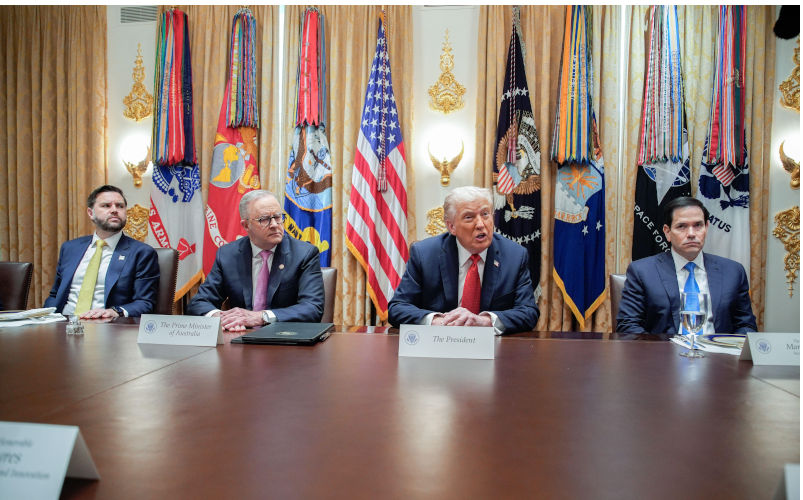China, US or us? Australia’s Upper Path in the global minerals race
October 24, 2025
The headlines are breathless: “ China versus the world,” proclaimed The Australian, quoting some very important people from the sheriff’s office urging allies to “decouple” from Beijing and unite against China’s “takeover of global rare earth supply chains”.
While Anthony Albanese and his team are working on that, why don’t we just call this what it is?
It’s not China versus the world – it’s China versus someone else. And we, like so many others, are once again being asked to pick a side in someone else’s fight, on someone else’s terms, for someone else’s strategic gain.
The latest chapter of this epic rivalry is dressed in minerals, manufacturing and moral clarity. Beijing has announced that global companies must now seek approval before exporting products containing Chinese-sourced rare earths – a significant move, considering how embedded these materials are in the world’s tech and defence supply chains.
This isn’t unprecedented. It closely mirrors Washington’s own sweeping controls on advanced chips and AI hardware, where global firms — including those in allied countries — must now seek US approval before exporting goods with even a sliver of American-origin tech to China.
And once again, Canberra is being nudged to “join the team”, show loyalty and dig faster.
However, the real question isn’t whose team we’re on – it’s what future we’re building for ourselves.
Beneath the chest-beating and soundbites, lies something far more consequential: a rare moment to rethink how we manage the mineral riches beneath our feet and avoid repeating the policy failures of the last resource boom.
Australia has always known it is resource-rich. What it hasn’t always done is convert that advantage into lasting national strength. In the last cycle, we let foreign companies dig out coal, gas and iron ore, ship them overseas and bank the profits offshore. What remained at home? High domestic prices, environmental damage, and — unlike Norway or the UAE — no sovereign wealth fund directly built from our mining boom. They built futures. We padded quarterly profits – just not ours.
Now, with fossil fuels waning and clean energy ascendant, the danger repeats itself. Australia holds 36 of the 50 minerals the US classifies as “critical". Yet, if we treat these as bulk cargo, we’ll again export our ingredients and import the future framed for us.
This isn’t about who we will side with. It’s about whether we side with ourselves.
At times like this, it may be wiser to think less in terms of camps, and more in tiers – as Chinese strategists have long done. When faced with complexity — from ancient military manuals to modern statecraft — they often organise choices into three paths: 上策 (shàng cè), the Upper Path; 中策 (zhōng cè), the Middle Path; and 下策 (xià cè), the Lower Path. It’s not that Beijing always governs this way, but the framework still shapes how many in China approach leverage, risk and timing. And perhaps Canberra, too, could benefit from thinking in paths, not poles.
The Upper Path is to stop acting like a quarry and start behaving like a sovereign industrial nation. This means building an Australia-led critical minerals ecosystem. Not just digging faster. Not just finding new customers. But investing in processing, manufacturing and long-term economic control.
The vehicle for this should be something like a Critical Minerals Sovereign Wealth Fund — financed by royalties and equity stakes — that channels revenue into rare earth processing, battery-grade material refining, magnet and component manufacturing and domestic industrial partnerships. Where foreign investment is welcomed, it must come with binding conditions: technology transfer, revenue sharing, skills development and local job creation.
Norway did this with oil. We failed to do it with gas. This time, we hold rare leverage – global markets are actively searching for reliable supply. Let’s not give that advantage away for some fancy words or photo opportunities, which literally means free.
The Middle Path is to hedge quietly. Smile at the sheriff. Trade with China. Attend summits. Sign communiqués. Say all the right things about “resilience” and “alignment”, while letting the core structures go untouched. Processing stays offshore. Revenue stays offshore. And Australia stays small in a game where it owns the ball. This path buys short-term calm, but builds no long-term strength. When geopolitical winds shift, we’ll find ourselves stranded between powers – with no real industry of our own.
The Lower Path — and one already echoing through press conferences and policy circles — is to shout louder, salute harder and frame minerals as the next ideological battlefield. It easily wins applause from the sheriff and earns nods from retired politicians and some media outlets, foreign-owned but draped in local colours, cheering that “Albo finally shows some backbone".
But the risk is high – not just to trade, but to sovereignty. Let’s not forget: just four years ago, when our relationship with China hit a low point, it was those so-called allies whose beef, wine and other exports quickly filled the gaps in the Chinese market we were pushed out of.
And let’s not kid ourselves – “friendshoring” sounds great at a press conference, but global firms will always prioritise cost, scale,and supply stability. Loyalty doesn’t guarantee market access. It only narrows our options.
Australia absolutely should build resilient, transparent supply chains — but as a sovereign actor, not a subcontractor. That means setting firm rules on investment, mandating local processing and making sure that our mineral wealth doesn’t become yet another pawn on someone else’s chessboard.
Because the real question isn’t “Whose side are we on?”
It’s “What are we building?”
We can be the world’s quarry again, or we can anchor a smart, sovereign and strategic clean energy future.
Let others play their term-long games.
Let Australia play for the long term.
The views expressed in this article may or may not reflect those of Pearls and Irritations.
